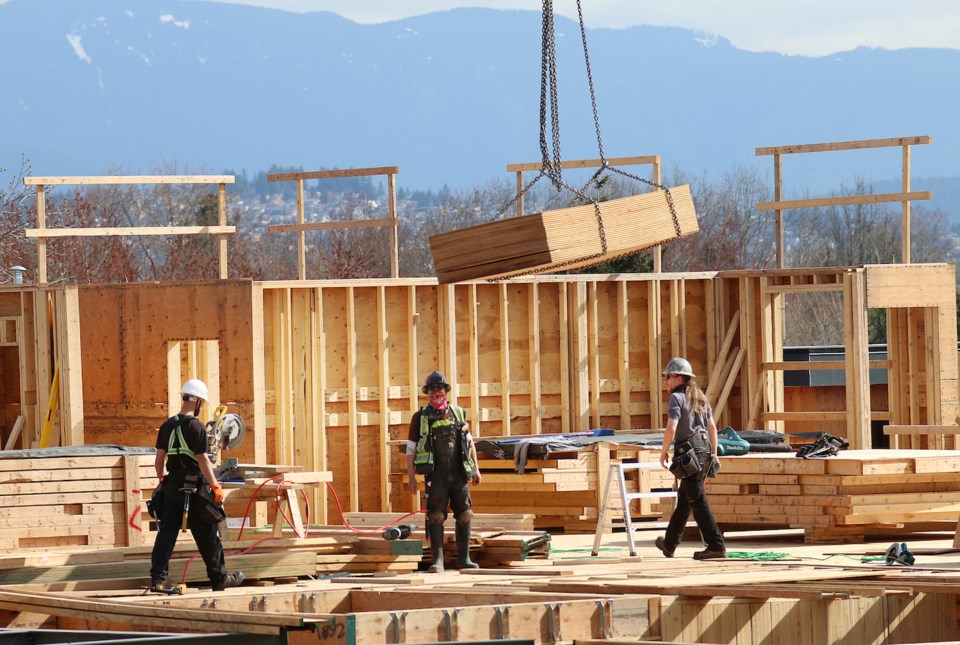Construction is one of the largest single sectors of the B.C. economy, accounting for nearly 10 per cent of the province’s GDP. The housing, institutional and infrastructure projects the sector’s 225,000 workers deliver each year made the sector an essential service when COVID-19 hit.
Now, as the economy returns to normal, it’s almost as if nothing has changed.
But warning flags are rising on input costs and a potential labour shortage.
According to the Independent Contractors and Businesses Association, construction activity fell by just under 10 per cent in 2020. But, by the end of the second quarter 2021, construction activity had snapped back to pre-pandemic levels.
The value of major projects proposed and on the go in the province increased 5 per cent to $349 billion in March versus a year ago. Statistics Canada is forecasting nearly $33.4 billion worth of new construction investment in B.C. this year, driven by the public and institutional sectors as well as transportation and logistics.
“Absolutely nothing has changed with us,” said Kevin Mierau, president of Mierau Contractors Ltd. in Abbotsford, which handles commercial projects as well as some multi-family construction.
A director of the Vancouver Regional Construction Association (VRCA) and the BC Construction Safety Alliance, Mierau said the industry was able to quickly implement safety protocols that complied with public health requirements. Those remain in place and have kept the industry working through the pandemic and into reopening.
“We really nailed down our process and protocol on site,” he said.
What has changed as the broader economy has returned to normal is construction costs. As construction returns to normal, demand has pushed prices for many materials sky-high. While lumber has grabbed headlines, almost all materials are affected.
According to Statistics Canada, costs for lumber and wood products were up 226 per cent in May relative to January 2020, while fabricated metal products and construction materials had increased 114.7 per cent. The cost of cement and glass was double that of January 2020.
“COVID protocols that have been put in place in a lot of manufacturing facilities quite simply reduced productivity,” Mierau said. “They’re producing less, but they’re having orders for more, so it comes to a point where no matter what the price is, [builders] just can’t get enough for what they need to build.”
VRCA vice-chair Craig Mitchell of Black Box Modular Solutions in Vancouver says the situation means builders need to take what’s available rather than be choosy. This is the case for everything from pipes to electrical panels.
“Right now we’re just telling owners, ‘This is what you get; you don’t get a choice anymore,’” he said. “To keep projects moving, it’s whatever is in stock that doesn’t affect schedule is pretty much what a lot of owners are having to go with now.”
While lumber prices could come back to more acceptable levels by the end of the year, Mitchell expects supply chains to be challenged well into 2022 and potentially beyond. With housing in demand and infrastructure projects such as the Broadway subway project in Vancouver starting up, building materials will be in high demand.
“There’s going to be a lot of construction for the next two years here, and that’s just going to put further pressure on the supply chain,” he said.
The good news is that money is cheap thanks to low interest rates, keeping projects moving. While this could stoke inflationary pressure, core inflation has shown few signs of budging. Moreover, end-users – at least of housing – have been willing to absorb the increases.
“People are willing to pay that price in this market, and that’s going to be the driver,” Mitchell said. “We’re seeing pressure on pricing in construction materials, but … I haven’t seen a slowdown.”
Higher prices for materials are compounding elevated prices for labour, an issue that persisted through the pandemic. The industry continues to face a shortage of new skilled workers to meet the projected demand of 60,000 workers by 2030.
ICBA president Chris Gardner said a new compulsory training regimen the province is introducing for trades adds to the regulatory burden on builders. A recent World Bank study ranked Canada 64th for permitting times, and new regulations as well as rising construction costs will further hamper new development.
“The dramatic and rapid price increases on nearly every construction material has been staggering,” Gardner said. “Owners are seeing bids for projects skyrocket and contractors are no longer able to provide fixed price quotes for work. If the situation does not ease, there could be a knock-on effect of project delays compounding cost and affordability pressures.”
The impacts are already being felt, Mierau said.
“Every project that’s over budget takes a little more from the pot for the next ones,” Mierau said. “We’re that next round away from seeing cutbacks, or things slowing down, in what conceivably should be a hot market.”



